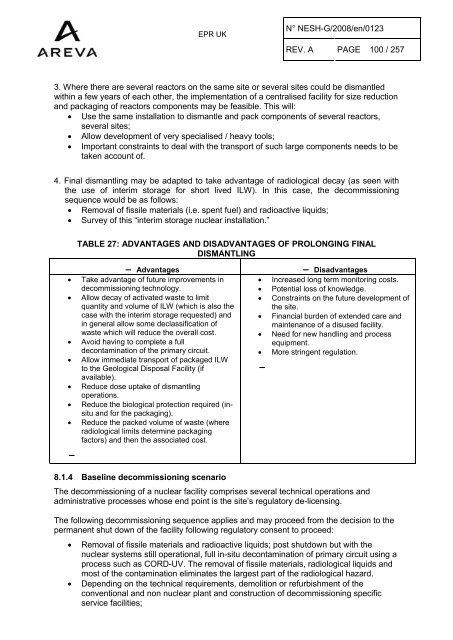Solid Radioactive Waste Strategy Report.pdf - UK EPR
Solid Radioactive Waste Strategy Report.pdf - UK EPR
Solid Radioactive Waste Strategy Report.pdf - UK EPR
Create successful ePaper yourself
Turn your PDF publications into a flip-book with our unique Google optimized e-Paper software.
<strong>EPR</strong> <strong>UK</strong><br />
N° NESH-G/2008/en/0123<br />
REV. A PAGE 100 / 257<br />
3. Where there are several reactors on the same site or several sites could be dismantled<br />
within a few years of each other, the implementation of a centralised facility for size reduction<br />
and packaging of reactors components may be feasible. This will:<br />
· Use the same installation to dismantle and pack components of several reactors,<br />
several sites;<br />
· Allow development of very specialised / heavy tools;<br />
· Important constraints to deal with the transport of such large components needs to be<br />
taken account of.<br />
4. Final dismantling may be adapted to take advantage of radiological decay (as seen with<br />
the use of interim storage for short lived ILW). In this case, the decommissioning<br />
sequence would be as follows:<br />
· Removal of fissile materials (i.e. spent fuel) and radioactive liquids;<br />
· Survey of this “interim storage nuclear installation.”<br />
TABLE 27: ADVANTAGES AND DISADVANTAGES OF PROLONGING FINAL<br />
DISMANTLING<br />
– Advantages – Disadvantages<br />
· Take advantage of future improvements in<br />
decommissioning technology.<br />
· Allow decay of activated waste to limit<br />
quantity and volume of ILW (which is also the<br />
case with the interim storage requested) and<br />
in general allow some declassification of<br />
waste which will reduce the overall cost.<br />
· Avoid having to complete a full<br />
decontamination of the primary circuit.<br />
· Allow immediate transport of packaged ILW<br />
to the Geological Disposal Facility (if<br />
available).<br />
· Reduce dose uptake of dismantling<br />
operations.<br />
· Reduce the biological protection required (insitu<br />
and for the packaging).<br />
· Reduce the packed volume of waste (where<br />
radiological limits determine packaging<br />
factors) and then the associated cost.<br />
–<br />
8.1.4 Baseline decommissioning scenario<br />
· Increased long term monitoring costs.<br />
· Potential loss of knowledge.<br />
· Constraints on the future development of<br />
the site.<br />
· Financial burden of extended care and<br />
maintenance of a disused facility.<br />
· Need for new handling and process<br />
equipment.<br />
· More stringent regulation.<br />
The decommissioning of a nuclear facility comprises several technical operations and<br />
administrative processes whose end point is the site’s regulatory de-licensing.<br />
The following decommissioning sequence applies and may proceed from the decision to the<br />
permanent shut down of the facility following regulatory consent to proceed:<br />
· Removal of fissile materials and radioactive liquids; post shutdown but with the<br />
nuclear systems still operational, full in-situ decontamination of primary circuit using a<br />
process such as CORD-UV. The removal of fissile materials, radiological liquids and<br />
most of the contamination eliminates the largest part of the radiological hazard.<br />
· Depending on the technical requirements, demolition or refurbishment of the<br />
conventional and non nuclear plant and construction of decommissioning specific<br />
service facilities;<br />
–

















